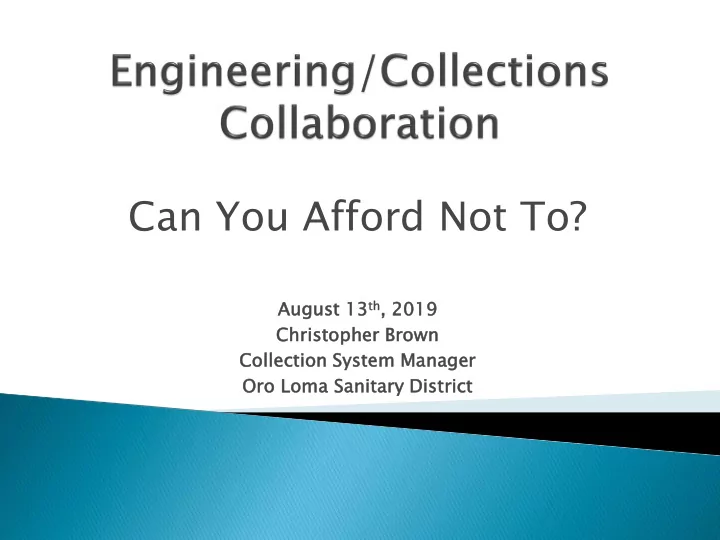

Can You Afford Not To? Au Augu gust 1 13 th th , 201 2019 Chris ristoph pher B Bro rown Colle llectio ion S System M Manager Oro ro Loma Sanit itary ry Dis Distri rict
30 years in construction and plumbing and under ground sewer construction. 1989-1999: Field Superintendent (specializing in high end residential/commercial remodel) 1999-2003: Plumbing Supervisor (all phases of residential/commercial and underground) 2003-2015: Collection Worker 2015-2018: CCTV Lead Worker 2018-????: Collection System Manger Past SFBS Collection System Committee Chair
Cooperative arrangement in which two or more parties (which may or may not have any previous relationship) work jointly towards a common goal. Sounds pretty simple yet there is sometimes a disconnect between the wants and the needs of the different departments. Both departments have critical information that can lead to a mutual understanding. Without collaboration/communication both departments can find themselves at odds with each other and the end product is what suffers.
Engineering Collections Budgetary Constraints High Traffic Areas Difficulty of Access Property Rights Traffic Control Topography Easement Access Utility Conflict Ingress/Egress Jurisdiction High Frequency Technology Difficult Homeowners Cost Benefit Analysis Manhole Locations (10 year Payback?)
Collaboration begins with both departments understanding the needs of the other. Both departments need to understand the constraints placed on them. Do we have the funds? Do we have good condition assessment/CCTV data? Is the equipment a limiting factor? (Hydro and CCTV) Can the maintenance be safely performed? Do we have a right to be there? (clear and recorded easement documents) What type of access do we have to easements? (gates, roadways, paths, etc.) Will the work be a responsible expenditure of public funds? Is it cheaper to maintain it or rehabilitate it? Is there an alternative solution? (point repair, pipe bursting, lining, etc.)
Do the CCTV crews realize that “junk in is junk out”? Have the crews ever watched the final videos to see the product they are delivering? When documenting defects of a sewer line segment, have the CCTV crews seen the still photos attached to videos? (QAQC) When defects/repairs are submitted by the CCTV crews how long do they sit in the que before they are assigned to a project? Is this known to all? When putting out a point repair or line replacement project when do you solicit weigh in from the field crews? ( 70%?, 80%? ) If you do not , then WHY NOT? Does the weigh in lead to buy in? Is the field crew input taken into consideration? The needs and wants of the field crew may have significant impact. Are you considering that the field crews will have to maintain this for the next 100 years?
Have you actively listened to the safety concerns, access issues, travel times, difficult homeowners, and pets or pest issues? Are there limitations to the equipment used for maintenance? How far will the CCTV camera go? How steep of a grade will the Hydro-Jetter climb? Are the utility access covers in the correct locations depicted on your current mapping system? Can they or should they be moved? How can we make this a better product? Can we change something to improve or upgrade the existing situation.
Manhole Removed
Missed Opportunity
How do you communicate with each other? How often do you meet? What level of involvement would you like? Does everyone understand WHY? Do you take the time to ensure everyone involved understands? Do you work together or in opposition to each other? ASK YOURSELVES THESE QUESTIONS
Recommend
More recommend